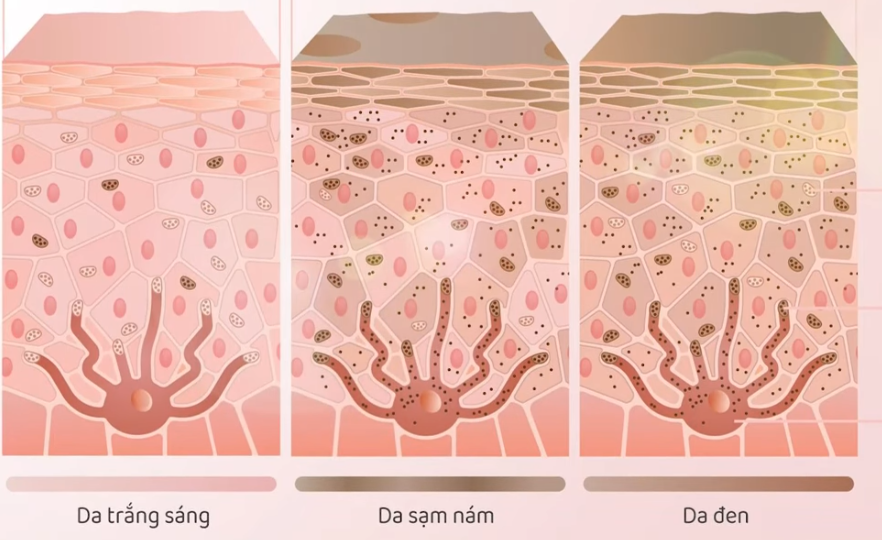First of all, it must be said that this is not an article that discriminates based on skin color or hair type, but simply an explanation. African people often have dark skin and curly hair, which is the result of thousands of years of evolution to adapt to the specific living environment on this continent, and why Europeans have white skin while Asians have yellow skin. This is not random but is due to natural selection.
If you live in one place for too long, your body will gradually adapt to that environment, and we will explore this in more detail in this article. Skin color here is essentially a natural sunscreen; dark skin is the result of increased production of a substance called melanin.

Melanin is a pigment responsible for our skin color; it acts as a shield for the body, blocking harmful effects from ultraviolet rays, also known as UV rays, in sunlight. You can imagine melanin as the body's natural sunscreen. It is not only present in humans but also in animals, responsible for the color of skin, hair, eyes, and some other parts of the body. Melanin plays a very important role in protecting the skin from ultraviolet rays. This is a substance produced by special cells in the skin called melanocytes.
In Africa, sunlight is very strong and almost shines down all day because this area is near the equator; strong sunlight increases the risk of skin damage such as sunburn, premature aging, and more dangerously, skin cancer. Melanin helps absorb some of the UV rays and protects the DNA in cells from being damaged. The darker the skin, the more melanin there is, and the higher the ability to protect against the harmful effects of light. A simple example is if you go to the beach in the summer and forget to apply sunscreen, your skin will get sunburned and red. But if your skin is naturally dark like someone living in Africa, this layer of melanin will minimize damage to you.
In addition, melanin not only prevents skin damage but also helps the body retain folic acid, which is a very important vitamin, especially for pregnant women, as it helps the fetus develop the brain and spinal cord. Sunlight can destroy folic acid in the body, so melanin plays a protective role for this resource. You can think of melanin as a health insurance that helps the body avoid risks caused by UV rays.
What about curly hair?

The curly hair of African people is also a clear example of adaptation to the climate. Imagine this: on a hot summer day, if you walk under the scorching sun with straight, thick hair, your scalp will feel suffocated, air will not circulate easily, and your head will be hotter. However, natural curly hair, with its twisted strands, creates many small spaces between the hair strands, allowing air to circulate more easily, cooling the scalp and regulating body temperature. Simply put, curly hair acts like a natural air conditioning fan on your head, helping the body not to overheat in hot weather.
Moreover, curly hair acts like a hat shielding the head from sunlight, protecting the head from direct sunlight. If the hair is straight and smooth, sunlight will easily penetrate the hair strands and heat the head, but with curly hair, the curls will block the sunlight from hitting the scalp directly. You can compare the curly hair of African people to a mobile sunshade or umbrella.
The changes in skin color and curly hair of African people did not happen overnight but took thousands of years.

Throughout this process, the human body has gradually adapted to survive and thrive better in harsh environments. In places with hot and sunny climates like Africa, people with darker skin and natural curly hair have a higher survival advantage because they can better protect their bodies from the effects of the weather. We can compare this to how plants adapt to their living environments. For example, in the desert, cacti develop sharp thorns instead of leaves to reduce water loss, while their stems are succulent to store the rare rainwater. Similarly, the bodies of African people have developed features suited to their living conditions: dark skin to combat sunlight and curly hair to regulate temperature.
What about comparing with Europeans?
People living in colder and less sunny regions show a clear difference; Europeans have white skin, with less melanin because they do not need to protect their skin from strong sunlight like in Africa. White skin helps the body synthesize vitamin D more easily from sunlight, mainly in areas far from the equator. If the skin is too dark, people in cold regions will struggle to produce enough vitamin D, which can lead to health issues such as osteoporosis. Additionally, Europeans have straight or slightly wavy hair because the cold climate does not require a natural air conditioner like curly hair. Straight hair retains heat more easily in freezing weather.

In other words, both skin color and hair type in humans in each region have developed in the best way to adapt to the natural environment. Asians, especially in East Asia and Southeast Asia, have evolved to live in areas with tropical and temperate climates. These regions have moderate sunlight, not as harsh as in Africa and not as weak as in Europe. Therefore, the amount of melanin that Asians produce is just enough to protect against UV rays but not so much that it darkens the skin excessively. In the history and culture of many Asian countries, yellow skin is often seen as a symbol of balance and harmony with nature. However, over time, some cultures in the region have different views on skin color; in some countries like Japan, South Korea, China, and Vietnam, white skin is often considered a symbol of beauty, while in some Southeast Asian countries, tanned skin is preferred.
So what would happen if Africans moved to Europe? What would their skin color be like?
Certainly, the skin color would not change immediately; it would take many generations to see a difference. This is because the process of changing skin color depends on evolution over many generations, not just the immediate adaptation of the body when changing environments. If a person of African descent moves to live in Europe, they will not naturally become whiter; the change in skin color can only occur when their genetic traits are naturally selected in the new environmental conditions. In other words, these changes will only appear in subsequent generations if the family lives in Europe for many years, hundreds of years, or even thousands of years.
Another factor that may contribute to changes in skin color in subsequent generations is interbreeding between ethnic groups. When a person of color marries and has children with a white person, the next generation may have lighter skin due to the combination of different genes. Over many generations, if intermarriage and reproduction continue in these communities, descendants may gradually have lighter skin suitable for the environment. Conversely, if a European moves to live in Africa for a long time, their skin will not immediately darken; they will face many health challenges due to having less melanin, which puts them at higher risk for sunburn and skin cancer. They often have to take protective measures such as wearing clothing, hats, and applying sunscreen.
Thus, we can conclude that the dark skin and curly hair of Africans are entirely due to the body's adaptation over thousands of years to the hot and sunny environment in Africa. Dark skin helps protect the body from UV rays and retain folic acid, while curly hair helps cool and protect the scalp. This is a great example of how the human body changes to fit living conditions, just as animal and plant species must evolve to survive in their environments.
